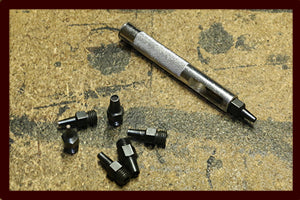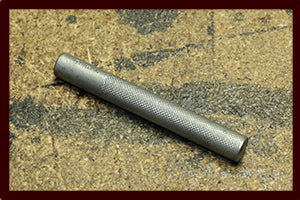The 5 Tools You Need To Work With Leather
This guide will show you the top 5 most essential tools needed to start working with leather, no matter what type of leather craft you’re learning. As you evolve and define your work, you’ll find more use for other tools that perform specific tasks. If you follow this guide to getting started, you’ll save yourself money by not purchasing tools you’ll never use. Plus, we’ll talk about some of the secondary tools used in the rewarding world of leather working.
See my YouTube channel for helpful leather 'How To' videos! Learn how to apply studs, snaps and more!
1. Rawhide Mallet

If you plan to work with leather, you MUST have a rawhide mallet. Many leather tools require a mallet. Punching holes, stamping leather, setting snaps, the list is endless. A medium weight mallet is a great place to start (10-12 ounce).
2. Hole Punch Set
You make a lot of holes working with leather. You’ll find there are generally two different sizes of hole punch sets(each set has about six different bits) The smaller set is the one you should get first. Don’t get a rotary punch set.
3. Bone Folder
Not made from bone anymore, if ever. A four-in-one plastic tool you must have. It burnishes edges, creases, folds, and slicks. Add finishing touches to your work. For about $3, bone folders provide an amazing amount of usefulness, and they’ll last forever.
4. Concave Rivet Setter
With your rivet setter in one hand, and a mallet in the other, you can set double cap rivets and hold multiple layers of leather in place. Concave on one end, flat on the other, flip it around to give your rivets a flat or curved look. (Be careful flattening them, watch my video to learn how to set rivets)
5. Awl

The awl is so simple, it’s a hard, short piece of steel with a wooden handle. Much thicker than a leather sewing needle. Use it to mark leather, or for puncturing holes. Also helps with sewing tasks, or as a temporary hold between two points, widening holes. An entire article could be written about an awl’s usefulness. I keep several around me at different work stations.
Excluding the mallet, which can run $20-$40, the remaining tools mentioned can be purchased for around $20 total.
As you develop your skills and begin to add complexity to your work, you’ll need more than just 5 simple tools. On the next page, we’ll look at a few of the secondary tools and accessories we use in leather. Some of these come in different sizes, so that’s why it’s important to know the basics about handling leather before you jump into the larger purchases.
Subscribe to my channel, then read more about leather tools.
